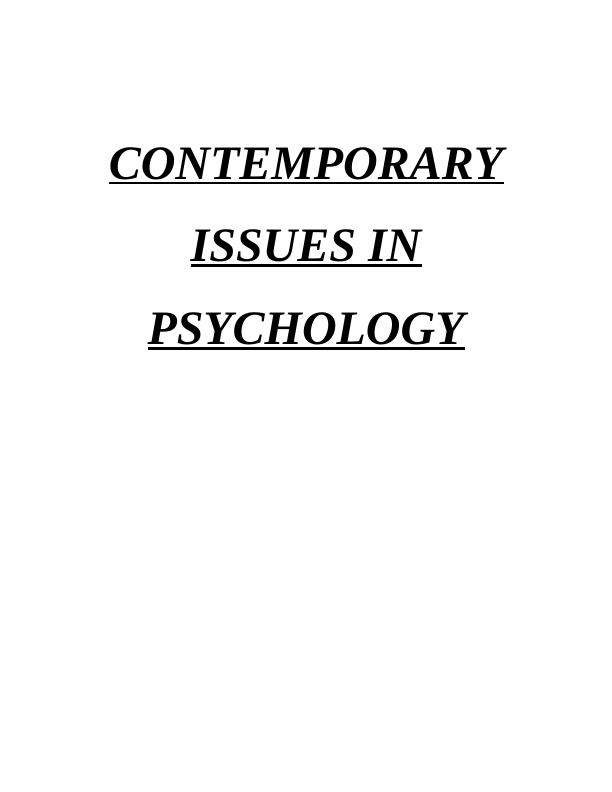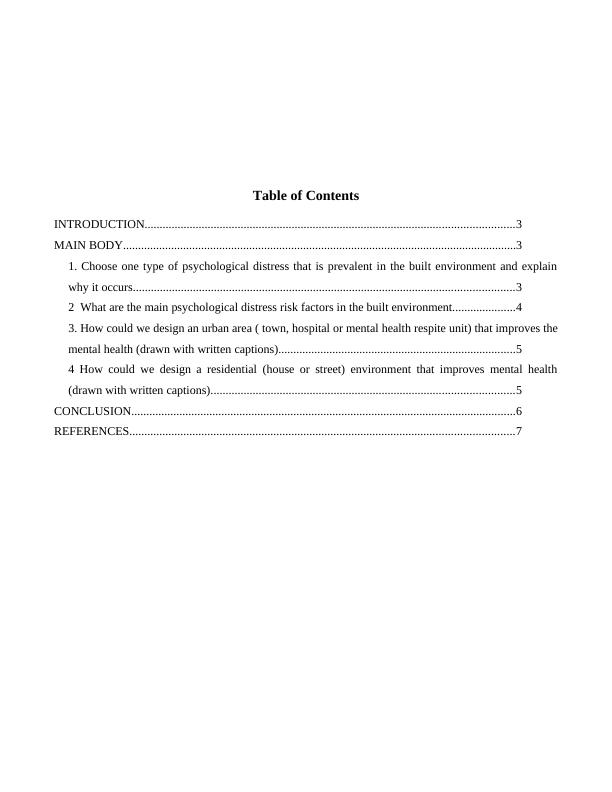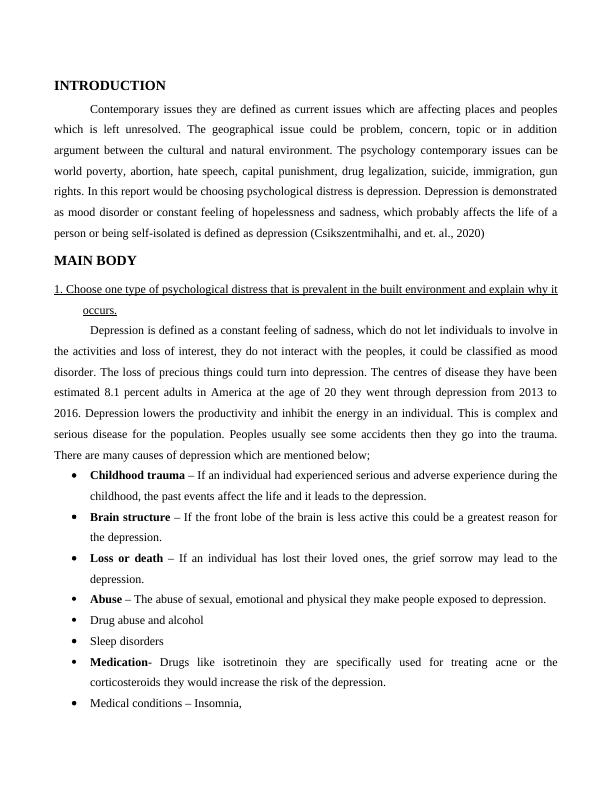Contemporary Issues in Psychology
Added on 2022-12-16
7 Pages1517 Words57 Views
CONTEMPORARY
ISSUES IN
PSYCHOLOGY
ISSUES IN
PSYCHOLOGY

Table of Contents
INTRODUCTION...........................................................................................................................3
MAIN BODY...................................................................................................................................3
1. Choose one type of psychological distress that is prevalent in the built environment and explain
why it occurs...............................................................................................................................3
2 What are the main psychological distress risk factors in the built environment.....................4
3. How could we design an urban area ( town, hospital or mental health respite unit) that improves the
mental health (drawn with written captions)...............................................................................5
4 How could we design a residential (house or street) environment that improves mental health
(drawn with written captions).....................................................................................................5
CONCLUSION................................................................................................................................6
REFERENCES................................................................................................................................7
INTRODUCTION...........................................................................................................................3
MAIN BODY...................................................................................................................................3
1. Choose one type of psychological distress that is prevalent in the built environment and explain
why it occurs...............................................................................................................................3
2 What are the main psychological distress risk factors in the built environment.....................4
3. How could we design an urban area ( town, hospital or mental health respite unit) that improves the
mental health (drawn with written captions)...............................................................................5
4 How could we design a residential (house or street) environment that improves mental health
(drawn with written captions).....................................................................................................5
CONCLUSION................................................................................................................................6
REFERENCES................................................................................................................................7

INTRODUCTION
Contemporary issues they are defined as current issues which are affecting places and peoples
which is left unresolved. The geographical issue could be problem, concern, topic or in addition
argument between the cultural and natural environment. The psychology contemporary issues can be
world poverty, abortion, hate speech, capital punishment, drug legalization, suicide, immigration, gun
rights. In this report would be choosing psychological distress is depression. Depression is demonstrated
as mood disorder or constant feeling of hopelessness and sadness, which probably affects the life of a
person or being self-isolated is defined as depression (Csikszentmihalhi, and et. al., 2020)
MAIN BODY
1. Choose one type of psychological distress that is prevalent in the built environment and explain why it
occurs.
Depression is defined as a constant feeling of sadness, which do not let individuals to involve in
the activities and loss of interest, they do not interact with the peoples, it could be classified as mood
disorder. The loss of precious things could turn into depression. The centres of disease they have been
estimated 8.1 percent adults in America at the age of 20 they went through depression from 2013 to
2016. Depression lowers the productivity and inhibit the energy in an individual. This is complex and
serious disease for the population. Peoples usually see some accidents then they go into the trauma.
There are many causes of depression which are mentioned below;
Childhood trauma – If an individual had experienced serious and adverse experience during the
childhood, the past events affect the life and it leads to the depression.
Brain structure – If the front lobe of the brain is less active this could be a greatest reason for
the depression.
Loss or death – If an individual has lost their loved ones, the grief sorrow may lead to the
depression.
Abuse – The abuse of sexual, emotional and physical they make people exposed to depression.
Drug abuse and alcohol
Sleep disorders
Medication- Drugs like isotretinoin they are specifically used for treating acne or the
corticosteroids they would increase the risk of the depression.
Medical conditions – Insomnia,
Contemporary issues they are defined as current issues which are affecting places and peoples
which is left unresolved. The geographical issue could be problem, concern, topic or in addition
argument between the cultural and natural environment. The psychology contemporary issues can be
world poverty, abortion, hate speech, capital punishment, drug legalization, suicide, immigration, gun
rights. In this report would be choosing psychological distress is depression. Depression is demonstrated
as mood disorder or constant feeling of hopelessness and sadness, which probably affects the life of a
person or being self-isolated is defined as depression (Csikszentmihalhi, and et. al., 2020)
MAIN BODY
1. Choose one type of psychological distress that is prevalent in the built environment and explain why it
occurs.
Depression is defined as a constant feeling of sadness, which do not let individuals to involve in
the activities and loss of interest, they do not interact with the peoples, it could be classified as mood
disorder. The loss of precious things could turn into depression. The centres of disease they have been
estimated 8.1 percent adults in America at the age of 20 they went through depression from 2013 to
2016. Depression lowers the productivity and inhibit the energy in an individual. This is complex and
serious disease for the population. Peoples usually see some accidents then they go into the trauma.
There are many causes of depression which are mentioned below;
Childhood trauma – If an individual had experienced serious and adverse experience during the
childhood, the past events affect the life and it leads to the depression.
Brain structure – If the front lobe of the brain is less active this could be a greatest reason for
the depression.
Loss or death – If an individual has lost their loved ones, the grief sorrow may lead to the
depression.
Abuse – The abuse of sexual, emotional and physical they make people exposed to depression.
Drug abuse and alcohol
Sleep disorders
Medication- Drugs like isotretinoin they are specifically used for treating acne or the
corticosteroids they would increase the risk of the depression.
Medical conditions – Insomnia,

End of preview
Want to access all the pages? Upload your documents or become a member.
Related Documents
Psychology, Biological and social influences of depressionlg...
|11
|3309
|287
Understanding Depression: Clinical Manifestation and Psychopathologylg...
|12
|3430
|498
Research On Borderline And Mental Distress Disorderslg...
|6
|1919
|414
Trauma Patient: Prevalence, Pathophysiology, and Trauma-Informed Carelg...
|11
|3072
|135
Causes of Mental Health Disorders: Anxiety, Eating Disorder, Depressionlg...
|6
|1311
|81
Major Depressive Disorderlg...
|13
|3819
|22
